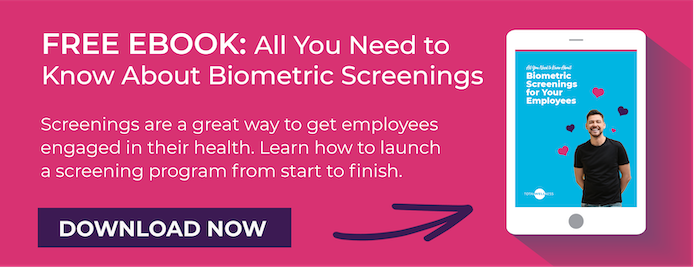 Have you been thinking about hosting a workplace wellness screening?
Have you been thinking about hosting a workplace wellness screening?
It may sound tricky, but it’s actually quite simple.
Wellness screenings are an easy way to set your employees up for a better health journey. It also provides you an accurate picture of what types of health problems plague your staff so you can create better wellness programs.
Based on the results, you and your team can make informed decisions surrounding health and well-being. Your wellness programs will thrive and so will your employees. It’s a win-win.
Ready to learn more?
Here we dive into the basics of screenings that can help your workers retain and regain their optimum health and wellness.
Wellness Screenings Basics
Wellness screenings — also known as biometric screenings — are a great preventative service to offer your employees.
Screenings give employees a snapshot of their current health. The results of the screenings can assist employers in tailoring wellness programs that are most relevant to health concerns employees are facing.
Did you know that 86 percent of employees say they don’t participate in wellness initiatives because they don’t have time? The same could probably be said for employees who skip their annual physical check-ups, too.
Corporate wellness screenings are an excellent way to help everyone skip that excuse. It gets employees to stay on top of their health before serious health issues arise.
A wellness screening should never replace an annual physical, but it could encourage employees to book their physical check-up based on the results of their screening.
Screening events show employees if they’re at risk for high blood pressure, heart disease, and other chronic illnesses.
While you can’t force employees to get their wellness screening done, you can encourage them by making the process as simple as possible.
Who Should Get a Wellness Screening?
Everyone! A wellness screening is an essential aspect of creating a successful corporate wellness program. Not only does it help employees assess their health to make appropriate lifestyle changes, but it also gives employers insight into ways to best serve their team with wellness programs.
What is Tested During Wellness Screenings?
A biometric screening is essentially a quick health exam. It’s not quite as in-depth as a physical, but it does account for important measurements that could indicate underlying health issues.
Biometric screenings measure the following health factors:
- Blood pressure
- Total cholesterol
- Waist circumference
- LDL and HDL cholesterol
- Height/Weight/Body Mass Index (BMI)
- Glucose (amount of sugar in the blood)
- Triglycerides (the amount of fatty acids in the blood)
Why are these important to measure?
- Blood pressure - Consistently high blood pressure may not have symptoms and can add to a variety of health issues. Learn more here about why high blood pressure is known as the “silent killer.”
- Total Cholesterol and HDL/LDL - There are two types of cholesterol: High-density lipoprotein (HDL) and Low-density lipoprotein (LDL). Too much LDL cholesterol (AKA the bad cholesterol) means you’re at an increased risk for heart disease and other serious health issues.
- Waist circumference - People who carry more fat around the waist — as opposed to hips — are at a greater risk for heart disease and type 2 diabetes.
- Height/Weight/Body Mass Index (BMI) - This measurement can provide details on if an individual is underweight, overweight, or obese.
- Glucose tolerance - This monitors the body’s response to sugar. It’s an important test as adults can develop diabetes with no symptoms.
- Triglycerides - This is a type of fat cell that stores unused calories for energy and shows your risk for certain heart conditions.
Individuals WILL NOT be screened for drug use, tobacco use, or HIV/AIDS.
Tests will include either a fingerstick or a blood draw. Fasting is optional. Individual results are not shared with the employer, but it will show overall trends in employee health.
What are the Benefits of Wellness Screenings?
As you can already see, there are several benefits to having these screenings done for both employees and employers. Here’s a better snapshot of how it benefits both parties:
For Employees
Employees may be hesitant. That’s okay. All employers can do is share the benefits with them and let them decide for themselves.
Benefits for employees include:
- Screenings complement regular doctor visits
- Provides a convenient way to get a screening
- Alerts employees to potential health problems before they become serious
For Employers
Healthy employees are the ones who perform best, generally. If they know they have underlying health concerns early on, they’re more likely to take care of them sooner. Leadership needs a healthy team to maintain the health of the company.
Benefits for employers include:
- Demonstrates concern for employee health
- Promotes well-being in the workplace overall
- Healthier employees may reduce insurance premiums
- Provides information for a more effective wellness program
- Healthier employees are typically more productive and absent less
Make Your Wellness Screening a Success
Planning an employee biometric screening is a step in the right direction in providing preventative healthcare assistance for your employees. Planning these types of events — especially if it’s your first one— can sometimes feel overwhelming.
We’re here to help with that, if you’d like. Check out our post on The Pros and Cons of Biometric Screenings Most Corporate Wellness Companies Won’t Tell You.
If you’re already convinced, here are a few ways to make it a successful event:
- Promote a healthy culture - It all starts with your company making wellness and preventative care an important part of your overall wellness initiative. Promote it often and in a playful and engaging way.
- Market your wellness program well - Highlight conditions that may be uncovered with a screening that you’ve already been marketing within the company wellness initiatives.
- Confirm confidentiality - Make sure employees know how the data is and isn’t shared to make them feel more comfortable about the screening process.
- Host a Q-and-A - A few weeks prior, consider hosting an informal Q-and-A session about the screening process. Employees may have questions about the screening and the company that hosts it. Make it easy for them to find answers.
- Don’t forget about remote employees - Your remote employees can participate as well with a mail-in kit.
That’s it! Wellness screenings are truly the most efficient and easy way to monitor the health of your staff.
If you’ve had a wellness screening done for your team, let us know in the comments below how your experience went!
If you have questions, feel free to reach out to our sales team. We’d be happy to answer any you have about the biometric screening process. It really is easier than you might think! Request a price quote here.



